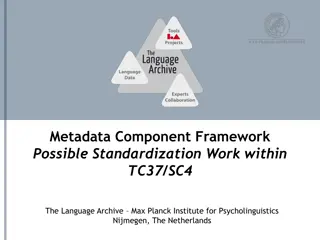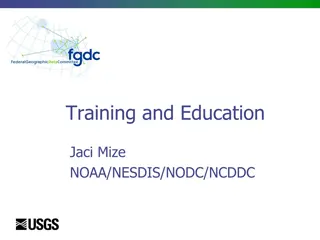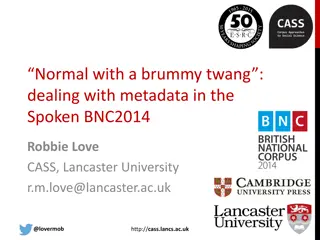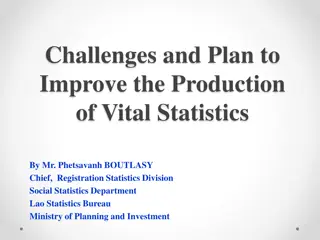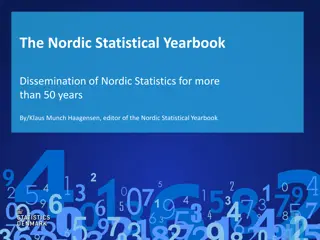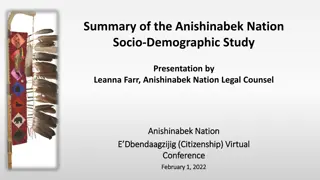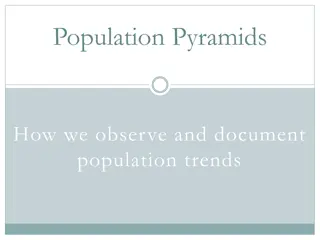Improvement of Population and Vital Statistics Metadata in the Demographic Yearbook System
The Demographic Yearbook system focuses on enhancing population and vital statistics metadata to ensure accurate and concise reflection of population concepts across 230+ countries. It involves annual collection of official national population estimates, vital statistics, and UN international travel and migration statistics. The system also incorporates data from Population and Housing Censuses, emphasizing the importance of coding schemes for different record types of population data. There is a call to recognize additional sources of population data, such as Population Registers, to enrich the coding scheme further.
Download Presentation

Please find below an Image/Link to download the presentation.
The content on the website is provided AS IS for your information and personal use only. It may not be sold, licensed, or shared on other websites without obtaining consent from the author.If you encounter any issues during the download, it is possible that the publisher has removed the file from their server.
You are allowed to download the files provided on this website for personal or commercial use, subject to the condition that they are used lawfully. All files are the property of their respective owners.
The content on the website is provided AS IS for your information and personal use only. It may not be sold, licensed, or shared on other websites without obtaining consent from the author.
E N D
Presentation Transcript
Population concepts used in the Demographic Yearbook system: Improvement of population and vital statistics metadata Adriana Skenderi Editor, UN Demographic Yearbook Demographic Statistics Section UN Statistics Division Statistics Division, EGM on Demographic Yearbook System, 9 12 November 2020
Official national population estimates (annually): data and metadata Vital statistics (annually): data and metadata UN International travel and migration statistics (annually) DEMOGRAPHIC YEARBOOK Population and Housing Censuses data and metadata: upon conducting of a census and availability of census results DATA COLLECTION https://unstats.un.org/unsd/demographic- social/products/dyb/index.cshtml#questionnaires
230 + countries and areas: an accurate, consistent and concise reflection of population concepts in relation to population data is needed. APPLICATION OF POPULATION CONCEPTS IN THE DEMOGRAPHIC YEARBOOK SYSTEM Guidance: Principles and Recommendations for Population and Housing Censuses, Revision 3
CODING SCHEME FOR POPULATION DATA (RECORD TYPES OF POPULATION DATA) Census de facto Census de jure Sample survey de facto Sample survey de jure Estimate de facto Estimate de jure Note: The above are the current record types used in the Demographic Yearbook system por population data. Each record type is composed of two concepts: 1) Source of population data (census, survey, or the set of population estimates produced by NSO) and 2) Type of population count
CODING SCHEME FOR POPULATION DATA : SOURCE There is a need to recognize additional and specific sources of population data and new types of population counts. Many countries provide to UNSD population data compiled from population registers. Therefore Population Register needs to be specifically recognized as a source in the Demographic Yearbook Collection coding scheme. With this addition, the sources of population data in DYB coding scheme will be: Census, Population Register, Survey, Estimate
CODING SCHEME FOR POPULATION DATA: SOURCE Census as a source is very broad. Do we want to recognize the different types of censuses in the coding scheme? Many countries conduct intercensal population counts. Should the intercensal population counts be recognized separately in the coding scheme? Census taking methodological approaches Traditional census - full field enumeration Combined census register(s) and ad-hoc surveys register(s) and existing surveys other (please describe) Rolling census Note: This information is already collected with the Population Census Metadata Questionnaire.
CODING SCHEME FOR POPULATION DATA: TYPE OF POPULATION COUNT Guidance: Principles and Recommendations on Population and Housing Censuses, page 176 Population present count A population present count is the simplest form of population count from a population census. People are enumerated at the place where they are found, usually the dwelling where they spend census night. Foreign residents who are in the country at the time of the census will be included but usual residents of the country who are absent at that time will be excluded. The major disadvantage of a population present count is that it does not enable a full count of usual residents to be derived and may not provide a true geographic distribution of usual residents for effective planning and policy purposes. Note: Population present count is already used in Demographic Yearbook Collection as De Facto
CODING SCHEME FOR POPULATION DATA: TYPE OF POPULATION COUNT Usual resident population count Countries increasingly prefer a usual resident population count because this count offers better information for planning and policy purposes on the demand for services, households, families and internal migration. A usual resident population count is a count of all usual residents of a country at the time of the census. Usual residents may or may not have citizenship of the country. Usual residents may include foreigners who reside or intend to reside in the country continuously for either most of the last 12 months or for 12 months or more, depending on the definition of place of usual residence that is adopted by the country. Conversely, persons who are normally resident in the country but who are temporarily absent should be included in the usually resident population. Note: Usual resident population count needs to be added in the Demographic Yearbook coding scheme. Until now, it has been covered, with footnotes, as part of De Jure population count.
With the addition of Population register as a source of population data and Usual resident population as a type of population count, there would be new record types as follows: Census, usual resident population Survey, usual resident population Population register, usual resident population Estimates, usual resident population Population register, de facto (present) population (?) CODING SCHEME FOR POPULATION DATA: ADDITIONAL RECORD TYPES Questions: 1) Can a population register produce a present population count? 2) Are there other types of population counts that should be recognized for the purpose of specific characterization of population data for international data collection?
Collected information: Census-taking methodology (type of census) Type of population count An indication of specific population groups that may be included or excluded Estimated census coverage Methods of estimating coverage error including information on whether a Post Enumeration Survey was conducted Several definitions: cities, urban/rural, literacy, education attainment, labour force status, housing, household characteristics, etc. CENSUS METADATA QUESTIONNAIRE Note: The Census metadata questionnaire was provided as a background document for this meeting. What other information should be collected that is relevant for contemporary population censuses?
POPULATION ESTIMATES METADATA QUESTIONNAIRE No information has been requested so far on the type of population count for population estimates as part of this questionnaire. The type of population count is requested only for population data from population censuses. The population estimates metadata questionnaire contains a tabulation on population groups that are included or excluded in the compilation of population estimates. The type of population count (de facto or present population, de jure, usual resident population) for population estimates is inferred from the responses to this tabulation and on the type of population count of base data. The type of population count for population estimates is not always very clear UNSD often follows up with NSOs on this issue Is there a need for population estimates to be qualified by type of population count? If yes, should such information be specifically requested from NSOs and provided as part of the Population estimates metadata questionnaire?
POPULATION ESTIMATES METADATA QUESTIONNAIRE At the request of Population Division of UN DESA, a specific option on the use of the cohort-component method to produce population estimates by age and sex will be added within the section Method of time adjustment .
VITAL STATISTICS DATA AND METADATA - Collected with the annual Vital Statistics Questionnaire - Vital events: Live births, deaths, infant deaths, foetal deaths, marriages, divorces, abortions - Total Fertility Rate, Complete and Abridged Life Tables - The first two worksheets of the questionnaires collect metadata available as a background document in the meeting s website https://unstats.un.org/unsd/demographic-social/meetings/2020/newyork-egm- dyb/docs/Vt-Metadata.xls
VITAL STATISTICS METADATA COLLECTED FOR LIVE BIRTHS, DEATHS, INFANT DEATHS, LATE FOETAL DEATHS, MARRIAGES, DIVORCES Quality of vital statistics obtained from civil registration I. Basis of tabulation Present basis of tabulation: - date of occurrence - date of registration How long has the present basis of tabulation been used? II. Estimated completeness of registration 100 per cent 90 - 99 per cent 80 - 89 per cent 70 - 79 per cent 60 - 69 per cent 50 - 59 per cent Under 50 per cent Please specify: (a) Year(s) to which completeness estimate refers (b) Basis of completeness estimate -Demographic analysis -Dual record check -Questions in population census -Questions in sample surveys -Other (specify) -No evaluation Please include any reports describing completeness of registration and methods used in arriving at estimated completeness:
VITAL STATISTICS METADATA - Currently, in DYB and related online datasets, vital statistics are qualified as complete (completeness of 90% or more), incomplete (completeness of less than 90 %), and no information on completeness - Completeness refers to the national level. Displaying more specific levels of completeness next to the data would provide an understanding of the gradual continuous improvements in civil registration and related vital statistics within countries. - Metadata are also collected for life tables, minimum legal marriage age, grounds for legally induced abortion, etc. - We welcome the expert s feedback on improvements to the currently collected metadata.




